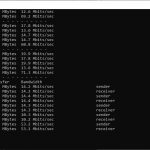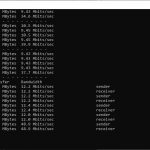We replicated the testing from our Ultimate Mesh WiFi Router Shootout as closely as possible with the NETGEAR Orbi AX6000. However, we no longer had the Apple Macbook Pro in our possession, so had to leave this set of tests out. On the plus side, we were lent a Dell Latitude 5490 that supports WiFi 6.
We repeated the positions from the Ultimate Mesh WiFi Router Shootout, with eight different locations for our test notebooks. The clients used were the Dell notebook mentioned above, an MSI WS63 7RK notebook with 2×2 802.11ac WiFi, and an older HP Folio 13, which maxes out at 3×3 802.11n WiFi.
In each case, we used the freely available iPerf 3.1.3 software, which stresses a network by sending packets of random data and measures the throughput. One system acts as a server, and the other as a client, as data is sent between them. For all tests, we used an Armari Windows 10 workstation connected to the primary router unit via Gigabit Ethernet as the server, so that the WiFi was always the slowest connection.
These are the iPerf commands we used:
For the server: iperf3 –s –i 1
For the client: iperf3 –c <IP Address> –P 4 –i 1 –t 60
Note that the client command sends four streams of data simultaneously, simulating a multi-client connection as closely as possible with just one client. It takes 60 throughput readings at one second intervals and then averages the result.
The above diagram shows the layout of the house we used for testing. Note that we didn't test on the top floor of the house because this was directly above the first floor and wouldn't have provided much of a range test. Instead, we used two locations on the same floor as the router (the first floor), then more distant locations on the ground floor extending out the back of the house into the garden.
Each test location, numbered in the diagram above, was approximately 5m away from the last one.
With the mesh networking and standalone router products used for comparison, location 1 was very near to the router, around 1m away. The next location – 2 – was around 5m away, with a wall in the way, but on the same floor. Location 3 was on the floor below, so had walls and a floor in between, but was a further 5m away. Location 4 was the last one actually inside the house. Locations 5 to 7 were then 5m further down the garden. Location 8 was only 2m further down, as this was the end of the garden, but also behind a shed, so posed a significant challenge that only a few mesh WiFi systems can cope with.
We should also say a few words about the location of the satellites. The routers or primary unit were always placed in the same location, in the first floor study next to the broadband. In the case of three-unit mesh systems such as BT Whole Home Wi-Fi and the top Velop option, the second and third satellites were placed at S1 and S2.
With the two-unit Google WiFi, the second unit was placed at S1, due to the recommendation of the setup software. However, in the case of the Orbi AC3000 RBK50, it was possible to place the second unit at S2, due to the signal strength from these systems.
For the Orbi AX6000 system, we also placed the primary unit in location R, with the satellite at S2, for a direct comparison with its predecessor.
802.11ac and WiFi 6 at 5GHz
We ran the 802.11ax WiFi 6 test alongside the 802.11ac one so you can see the performance benefit from the new standard.
Within 1m, the NETGEAR OrbiAX6000 puts up a good showing with 802.11ac, hitting 546Mbits/sec, which is amongst the best close range results we've seen. But in WiFi 6 mode, the bandwidth increases to 707Mbits/sec, which is on par with the non-mesh WiFi 6 NETGEAR Nighthawk AX12.
At 5m, the AX6000 is the best 802.11ac router we've seen, hitting 448Mbits/sec. But in WiFi 6 mode, performance has only dropped 10 per cent from 1m, achieving an even more impressive 635Mbits/sec. Moving to 10m, there's nothing to distinguish between 802.11ac and ax, with the AX6000 achieving 461Mbits/sec and 463Mbits/sec respectively – both absolutely stunning performances.
The 15m results are equally stunning, with 802.11ac bandwidth reaching an amazing 451Mbits/sec, way beyond any previous mesh system we've tested. But the WiFi 6 result is even better, and above the 10m result at 542Mbits/sec.
The 802.11ac bandwidth does drop to normal levels at 20m, reaching a merely good 107Mbits/sec. But WiFi 6 throughput is still at 376Mbits/sec. Moving out to 25m, the 801.11ac speed has dropped to a merely usable 18.9Mbits/sec. But WiFi 6 bandwidth is still at an incredible 86.4Mbits/sec, and it scarcely drops at a further 5m out to 30m, where it achieves 83.2Mbits/sec. Unfortunately, 802.11ac speed has dropped to just 5.87Mbits/sec.
The AX6000 couldn't deliver 802.11ac for the 32m “behind the shed” distance, but the WiFi 6 signal was still going strong to provide 27.6Mbits/sec.
Overall, these are truly amazing results. You're not getting extra 802.11ac range but you are getting phenomenal performance up to 20m. WiFi 6 performance and range are equally outstanding, however, making this easily the fastest WiFi we've seen with the best area coverage.
802.11n 2.4GHz
The picture with 2.4GHz 802.11n is much more pedestrian than with 5GHz 802.11ac and ax. The AX6000 only manages a run-of-the-mill 61.2Mbits/sec at 1m, and at 5m bandwidth is a fairly miserly 53.2Mbits/sec.
At 10m, the AX6000 manages an equally uninspiring 37.1Mbits/sec, but at 15m, the bandwidth improves again to 51.6Mbits/sec, and doesn't drop that far at 20m, hitting 48.9Mbits/sec.
At 25m, the AX6000 is starting to show its range abilities, still managing 39.2Mbits/sec, and at 30m, you're still getting a highly usable 22.9Mbits/sec. Even out as far as 32m, a just-about-usable 6.47Mbits/sec is available.
This isn't a performance win for the AX6000 with 802.11n, but you are at least getting usable bandwidth across a wide area, which will be beneficial for legacy 2.4GHz devices.
 KitGuru KitGuru.net – Tech News | Hardware News | Hardware Reviews | IOS | Mobile | Gaming | Graphics Cards
KitGuru KitGuru.net – Tech News | Hardware News | Hardware Reviews | IOS | Mobile | Gaming | Graphics Cards





























